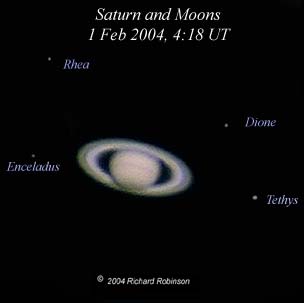 |
Scope: 8" LX 200 SCT |
| MX - 5C CCD | |
| This image of Saturn is similar to view you will have in an 8-10 scope at about 100 power, except the moons may appear slightly brighter. Click here for a larger image. | Focal Ratio: f10 through eyepiece projection |
| Exposure: 0.06 sec for planet, 7 sec for moons | |
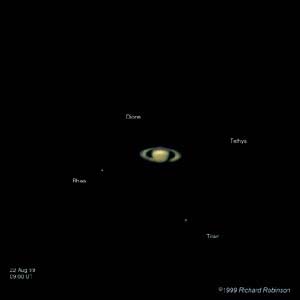 |
Scope:
8" LX 200 SCT
|
| MX-5C CCD Camera | |
| This image was taken on 22 Aug 99 at 09:00 UT. A 2X barlow lens was used to increase the focal ratio. Click here for a larger image. | Focal Ratio: f20 |
| Exposure: 0.8 sec, 15 sec moons | |
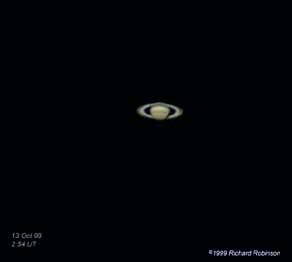 |
Scope:
8" LX 200 SCT
|
| MX-5C CCD Camera | |
| One of the sharpest images I've obtained of Saturn taken on 13 Oct 99. Click here for a larger image. | Focal Ratio: f20 |
| Exposure: 0.8 sec | |
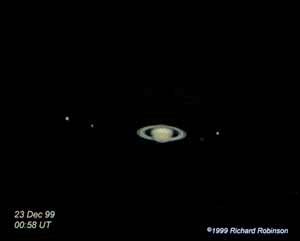 |
Scope:
8" LX 200 SCT
|
| MX-5C CCD Camera | |
| A very nice image of Saturn and four moons. Taken on 23 Dec 99. Click here for a larger image. | Focal Ratio: f20 |
| Exposure: 0.6 sec Planet, 30 sec moons | |
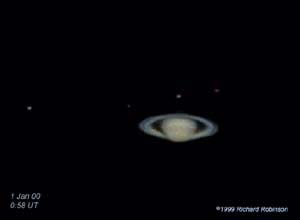 |
Scope:
8" LX 200 SCT
|
| MX-5C CCD Camera | |
| Focal Ratio: f30 | |
| My
first image of Saturn with the Orion 3X barlow, giving an effective
focal
ratio of f30. Taken on New Years Eve, EST.
Click here for a DOS PC program to calculate the position of Saturn's moons (68 K Zipped file). This program is freeware.
|
|
| Exposure:
two 1.0 sec images averaged for Planet; 5 sec for moons
|
|
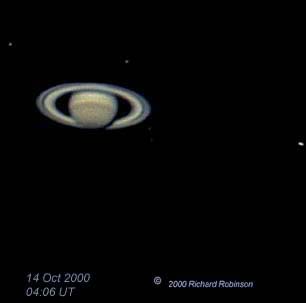 First image in the year 2000. Compare to the one above and note that the rings now appear more open. It's also much sharper. |
Scope: 8" LX 200 SCT |
| MX-5C CCD Camera | |
| Focal Ratio: f30 | |
| Exposure: Four 0.45 sec images averaged for Planet; 15 sec for moons | |
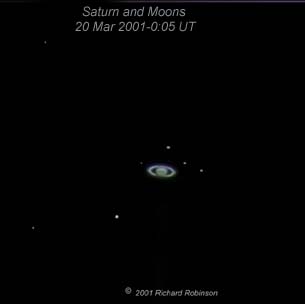 Saturn and five moons. This image approximates a telescope view at 100 power. The left two stars in the image are background stars. The brightest moon is Titan. |
Scope: 8" LX 200 SCT |
| MX-5C CCD Camera | |
| Focal Ratio: f10 | |
| Exposure: Five 0.01 sec images averaged for Planet; One 5 sec image for moons | |
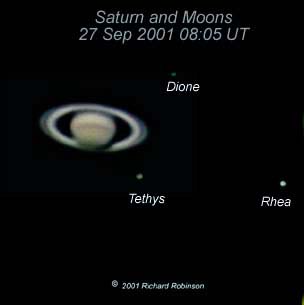 |
Scope: 8" LX 200 SCT |
| MX-5C CCD Camera | |
| Focal Ratio: f30 | |
| Exposure: Six 0.5 sec images averaged for Planet; 10 sec for moons | |
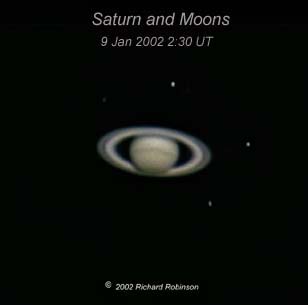
|
Scope: 8" LX 200 SCT |
| MX-5C CCD Camera | |
| Focal Ratio: f30 | |
| Exposure: Eight 0.45 sec images averaged for Planet; 5 sec for moons | |
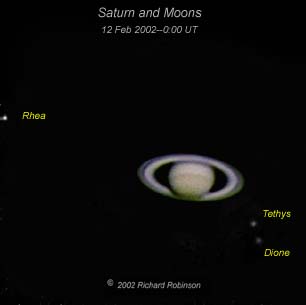 |
Scope: 8" LX 200 SCT |
| MX-5C CCD Camera | |
| Focal Ratio: f30 | |
| Exposure: Twelve 0.45 sec images averaged for Planet; 5 sec for moons | |
 |
Scope: 8" LX 200 SCT |
| MX-5C CCD Camera | |
| Focal Ratio: f30 | |
| Exposure: Fourteen 0.45 sec images averaged for Planet; 12 sec for moons | |
|
|
Scope: 8" LX 200 SCT |
| MX-5C CCD Camera | |
| Focal Ratio: f30 | |
| Exposure: Eight 0.45 sec images averaged for Planet; 2 sec for moons | |
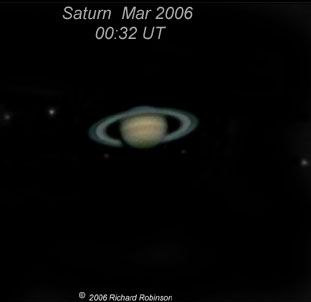
|
Scope: 8" LX 200 SCT |
| MX-5C CCD Camera | |
| Focal Ratio: f30 | |
| Exposure: Eight 0.05 sec images averaged for Planet; 2 sec for moons | |
|
|
|
